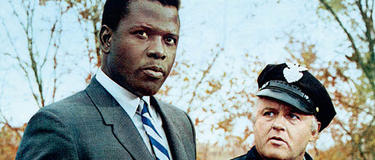 by Julian Spivey I lived far outside of town growing up and didn’t have a vehicle of my own so when my friends would hang out during summer between my junior and senior years of high school my best friend became Turner Classic Movies, where Robert Osborne would introduce me to Hitchcock, Ford, Huston, Lumet and more. One film that instantly struck me and became a favorite was Norman Jewison’s “In the Heat of the Night,” starring Sidney Poitier and Rod Steiger, a stunning one-two punch of leads. Growing up in Northern Arkansas where diversity doesn’t exist, it was important to see strong black men like Poitier, and my God, Poitier’s Det. Virgil Tibbs was not only strong, but cool. When plantation owner Endicott slaps Tibbs in the face without hesitation, Tibbs slaps him back. Oscar-nominated actor Laurence Fishburne would call it the “slap heard around the world” in an American Film Institute special and it was one of the most daring things put to film at that time. “In the Heat of the Night” won best picture in 1968 and often you’ll read pieces claiming more innovative or revolutionary films like “Bonnie and Clyde” or “The Graduate” should have won instead. But a movie featuring a black hero in the South, showing the white good ol’ boys how it’s done in ‘67 is about as revolutionary as it got in an era when Jim Crow laws had just been overturned. Visiting a relative in nowhere Mississippi in the turbulent ‘60s, Tibbs gets caught up in a crime where he’s first the suspected perp and later helps Steiger’s small town police chief solve. It’s the friendship between Tibbs and Chief Gillespie that I focused on. Gillespie and Tibbs start off as foes, but by the end of the movie come to respect one another, if not become borderline friends. It’s a message that despite differences, looks and beliefs we can all get along. And that’s something as important in today’s world as it was 50 years ago. It’s messages like these that make the medium of film truly important.
0 Comments
Leave a Reply. |
Archives
May 2024
|